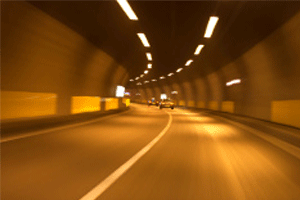You have no items in your shopping basket.
LEDs: The Light at the End of Many Tunnels across the World

Back in 2012, it was reported that a 14km (8.7 miles) tunnel in the United Arab Emirates was retrofitted with LED lighting. Considering the fact that LED lamps are more expensive to buy than their HPS or halogen counterparts, as well as the considerable amount of work involved in the project, this was quite a feat.
Yet it also shows how far LED lighting has come. Indeed, up until quite recently, LEDs were considered inefficient and therefore only useful in Christmas lights and electronic gadgets. Now LED lighting is used widely as a highly-efficient alternative for streetlights, warehouses and tunnels.
In fact, such is the popularity of LED lighting that we are certain it will soon become the standard form of lighting in most applications across the globe.
As a result of increasing urbanisation, the Ministry of Transport must invest tunnels to reduce congestion on the roads. But to ensure these tunnels provide a safe passage for drivers, the tunnels must obviously be well lit.
After all, safety is paramount. And to ensure safe passage, as well as the confidence and comfort of motorists, it must be easy to see other road users and objects. It must also be easy to judge distances so that drivers can find their way through the tunnel with ease.
So what’s the problem with traditional tunnel lighting?
Sodium-vapour (the traditional source of tunnel lighting) does not provide a consistent level of light. While it is reasonably cost-effective, sodium-vapour tunnel lighting suffers from frequent failure and must be subject to regular maintenance and repairs.
Traditional lighting also produces yellow light which can be hard on the eyes; especially in the case of the 14km-long tunnel described above.
Now, due to advances in technology, the authorities have a much more appealing option in LED tunnel lighting…
Superior lighting
The white light of LED tunnel lights allows the human eye to render colours and pick out object much more faithfully than the gaudy orange-brown light that sodium-vapour lights produce.
This enables drivers to judge distances better, but also provides a uniform level of light. Ingenious lens designs provide an even light pattern on the road without glare or shadows.
Low maintenance
LEDs are incredibly robust. As a result, they’re not prone to catastrophic failure like sodium-vapour lamps. This means there’s no need to shut down parts of the tunnel for costly and time-consuming maintenance work. This in turn reduces disruption and ensures that traffic is able to flow freely through the tunnel.
More control
Sodium-vapour units are designed to provide light equivalent to the open air during the brightest part of the day. The can often mean that a tunnel is over-lit. Our Tunnel LED Lights can include integrated dimmers and motion sensors as a means of providing exactly the right amount of light, and saving energy in the process.
